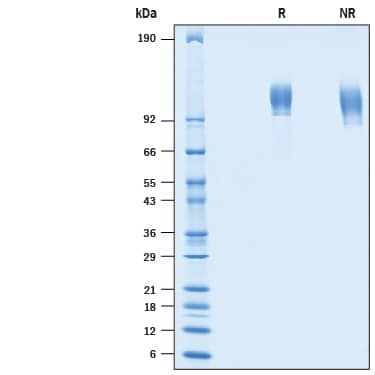Recombinant Human Siglec-2/CD22 His-tag Avi-tag Protein, CF
R&D Systems, part of Bio-Techne | Catalog # AVI10191
Biotinylated

Key Product Details
Learn more about Avi-tag Biotinylated Proteins
Source
CHO
Accession #
Structure / Form
Biotinylated via Avi-tag
Conjugate
Biotin
Applications
Bioactivity
Product Specifications
Source
Chinese Hamster Ovary cell line, CHO-derived human Siglec-2/CD22 protein
| Human Siglec-2/CD22 (Asp20-Arg687) Accession # CAA42006.1 |
GGGSGGGSGGGS | HHHHHHH | Avi-tag |
| N-terminus | C-terminus | ||
Purity
>95%, by SDS-PAGE visualized with Silver Staining and quantitative densitometry by Coomassie® Blue Staining.
Endotoxin Level
1.0 EU per 1 μg of the protein by the LAL method.
N-terminal Sequence Analysis
79 kDa
Predicted Molecular Mass
79 kDa
SDS-PAGE
92-118 kDa, under reducing conditions
Activity
Measured by its binding ability in a functional ELISA.
When Siglec-2/CD22 Antibody (hL22 (Epratuzumab)) - Chimeric (Novus Catalog # NBP2-75189) is immobilized at 0.5 µg/mL (100 µL/well), Biotinylated Recombinant Human Siglec-2/CD22 His-tag Avi-tag (Catalog # AVI10191) binds with an ED50 of 0.3-2.4 ng/mL.
Measured by the ability of the immobilized protein to support the adhesion of human red blood cells. Kelm, S. et al. (1994) Current Biology 4:965.
The ED50 for this effect is 0.1-0.8 μg/mL.
When Siglec-2/CD22 Antibody (hL22 (Epratuzumab)) - Chimeric (Novus Catalog # NBP2-75189) is immobilized at 0.5 µg/mL (100 µL/well), Biotinylated Recombinant Human Siglec-2/CD22 His-tag Avi-tag (Catalog # AVI10191) binds with an ED50 of 0.3-2.4 ng/mL.
Measured by the ability of the immobilized protein to support the adhesion of human red blood cells. Kelm, S. et al. (1994) Current Biology 4:965.
The ED50 for this effect is 0.1-0.8 μg/mL.
Scientific Data Images for Recombinant Human Siglec-2/CD22 His-tag Avi-tag Protein, CF
Recombinant Human Siglec-2/CD22 His-tag Avi-tag Protein Binding Activity
When Siglec-2/CD22 Antibody (hL22 (Epratuzumab)) - Chimeric (Novus Catalog # NBP2-75189) is immobilized at 0.5 μg/mL, 100 μL/well, Biotinylated Recombinant Human Siglec-2/CD22 His-tag Avi-tag (Catalog # AVI10191) binds with an ED50 of 0.3-2.4 ng/mL.Recombinant Human Siglec-2/CD22 His-tag Avi-tag Protein SDS-PAGE
2 μg/lane of Biotinylated Recombinant Human Siglec-2/CD22 His-tag Avi-tag (AVI10191) was resolved with SDS-PAGE under reducing (R) and non-reducing (NR) conditions and visualized by Coomassie® Blue staining, showing bands at 92-118 kDa.Formulation, Preparation and Storage
AVI10191
| Formulation | Lyophilized from a 0.2 μm filtered solution in PBS with Trehalose. |
| Reconstitution | Reconstitute at 500 μg/mL in PBS. |
| Shipping | The product is shipped at ambient temperature. Upon receipt, store it immediately at the temperature recommended below. |
| Stability & Storage | Use a manual defrost freezer and avoid repeated freeze-thaw cycles.
|
Background: Siglec-2/CD22
References
- Crocker, P.R. et al. (2007) Nat. Rev. Immunol. 7:255.
- Poe, J.C. and T.F. Tedder (2012) Trends Immunol. 33:413.
- Meyer, S.J. et al. (2018) Front. Immunol. 9:2820.
- Wilson, G.L et al. (1991) J. Exp. Med. 173:137.
- Stamenkovic, I. and B. Seed (1990) Nature 345:74.
- Collins, B.E. et al. (2004) Proc. Natl. Acad. Sci. 101:6104.
- Crocker, P.R. and A. Varki (2001) Immunology 103:137.
- Ravetch, J.V. and L.L. Lanier (2000) Science 290:84.
- Wienands, Y.J. et al. (1999) J. Biol. Chem. 274:18769.
- Pluvinage, J.V. et al. (2019) Nature. 5568:7751.
- Clark, E.A. et al. (2018) Front. Immunol. 9:2235.
Long Name
Sialic Acid Binding Ig-like Lectin 2
Alternate Names
BL-CAM, CD22, Siglec2
Gene Symbol
CD22
UniProt
Additional Siglec-2/CD22 Products
Product Documents for Recombinant Human Siglec-2/CD22 His-tag Avi-tag Protein, CF
Product Specific Notices for Recombinant Human Siglec-2/CD22 His-tag Avi-tag Protein, CF
For research use only
